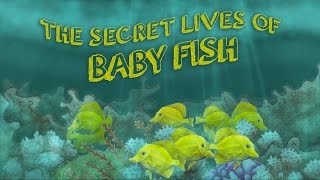(单词翻译:单击)
What you're looking at isn't some weird x-ray.
现在你所看见的不是奇怪的X射线。
It's actually a baby yellow tang surgeonfish at two months old.
它其实是一个两个月大的黄色刺尾鱼宝宝。
And you thought your childhood was awkward.
你可能会觉得你的童年很糟糕。
But here is the same fish as an adult,
但这是同一种鱼成年后的样子,
a beautiful inhabitant of the Indian and Pacific Oceans' coral reefs
是一种寄居在印度洋和太平洋的珊瑚礁里的美丽物种,
and one of the most popular captive fish for salt water aquariums.
也是被捕捉到咸水水族馆里最受欢迎的一种。
Of the 27,000 known fish species, over a quarter live on coral reefs that make up less than 1% of the Earth's surface.
在已知的两万七千种鱼类中,有超过四分之一的鱼类生活在只占地球表面不到百分之一的珊瑚礁中。
But prior to settling down in this diverse tropical environment,
不过在定居在这多样的热带环境中之前,
baby coral reef fish face the difficult process of growing up on their own,
珊瑚礁鱼宝宝们面对着独立生长的艰辛历程。
undergoing drastic changes, and the journey of a lifetime before they find that reef to call home.
它们在经历了剧烈的变动和一生的旅程后才能找到可以被称为家的珊瑚礁。
The life cycle for most of these fish begins when their parents spew sperm and eggs into the water column.
大多数这种鱼的生命周期,从它他们的父母将精子和卵子喷入水柱时开始。
This can happen daily, seasonally, or yearly depending on the species,
根据鱼的不同种类,这个过程可以在每天,每季或是每一年发生,
generally following lunar or seasonal tidal patterns.
一般都遵循月亮或是季节潮汐的变化。
Left to their fate, the fertilized eggs drift with the currents, and millions of baby larvae hatch into the world.
受精的卵子听天由命,随着洋流漂流,成千上万的鱼幼崽被孵化来到这个世上。
When they first emerge, the larvae are tiny and vulnerable.
最开始的时候,它们又小又脆弱。
Some don't even have gills yet and must absorb oxygen directly from the water through their tissue-thin skin.
有一些甚至连腮都没有,必须通过他它们极薄的皮肤,从水里直接呼吸氧气。
They may float in the water column anywhere from minutes to months,
它们在水柱中随处漂流,从几分钟到几个月,
sometimes drifting thousands of miles across vast oceans, far from the reefs where they were born.
有时会在茫茫大海中漂流上千英里,远离那些它们出生的珊瑚礁。

Along the way, they must successfully avoid predators,
这一路上,它们必须成功的躲避捕食者,
obtain food, and ride the right currents to find their way to a suitable adult habitat,
寻到食物,还要赶上正确的洋流以便到达一个适合成年鱼类栖息的地方,
which might as well be a needle in vast haystack of ocean.
这个过程有时就像大海捞针一样。
So, how did they accomplish this feat?
那么,它们是怎样完成这个壮举的呢?
Until recently, marine biologists thought of larval fish as largely passive drifters,
直到最近,海洋生物学家都认为鱼苗大都是被动的漂流者,
dispersed by ocean currents to distant locales.
依靠洋流分散到远处。
But in the last 20 years, new research has suggested that larvae may not be as helpless as they seem,
但是最近在二十年中,新的研究发现这些鱼苗也许并不像它们看起来那么无助,
and are capable of taking their fate in their own fins to maximize their chances of survival.
它们可以依靠它们的鳍决定自己的命运,并且将它们的生存几率最大化。
The larvae of many species are unexpectedly strong swimmers,
许多种类的鱼苗游动能力都出乎预料,
and can move vertically in the water column to place themselves in different water masses and preferentially ride certain currents.
它们可以在水柱中垂直移动,将自己带到不同的水体中,它们还会倾向搭乘一些特定的洋流。
These fish may be choosing the best routes to their eventual homes.
这些鱼类可能在选择到达最终家园地的最优路径。
When searching for these homes,
当它们在搜寻它们的最终家园时,
evidence suggests that larvae navigate via a complex suite of sensory systems, detecting both sound and smell.
有证据表明这些鱼苗通过一套复杂的感官系统进行导航,这套系统能够探测声音和气味。
Odor, in particular, allows larvae to distinguish between different environments, even adjacent reefs,
尤其是气味,可以让鱼苗区分不同的环境,即使是相邻的珊瑚礁也可以被分辨,
helping guide them toward their preferred adult habitats.
从而帮助它们找到更加合适的栖息地。
Many will head for far-flung locales miles away from their birth place.
很多鱼都漂向距离出生地几英里远的地方。
But some will use smell and other sensory cues to navigate back to the reefs where they were born,
不过也有一些鱼依靠嗅觉和其他的感官线索回到了它们出生的珊瑚礁,
even if they remain in the larval stage for months.
即使它们会在鱼苗阶段停留几个月。
So, what happens when larvae do find a suitable coral reef?
那么,在鱼苗们找了合适的珊瑚礁之后呢?
Do they risk it all in one jump from the water column, hoping to land in exactly the right spot to settle down and metamorphose into adults?
它们会抱着能够准确着陆的信心,孤注一掷的从水柱中跳出,然后变成成年的鱼么?
Not exactly. Instead, larvae appear to have more of a bungee system.
不一定。事实上,鱼苗似乎拥有一个更像是蹦极的系统。
Larvae will drop down in the water column to check out a reef below.
它们跳入水柱,检查下面的珊瑚礁。
If conditions aren't right, they can jump back up into higher water masses and ride on,
如果环境不理想,它们就会重新跳起进入更高的水体,继续前进,
chancing that the next reef they find will be a better fit.
期待下一个珊瑚礁会是更合适的栖息地。
But this is the point where our knowledge ends.
不过这些就是我们所了解的全部了。
We don't know the geographic movements of individual larva for most species.
我们既不知道大多数鱼类的单个鱼苗的地理移动,
Nor do we know which exact environmental cues and behaviors they use to navigate to the reefs they will call home.
也不知道它们用来寻找合适的珊瑚礁的确切的环境线索和行为。
But we do know that these tiny trekkers are more than the fragile and helpless creatures science once believed them to be.
但是我们知道,这些幼小的“徒步”旅行者绝不仅仅是科学所一度认定的脆弱无助的生物。
The secret lives of baby fish remain largely mysterious to us, unknown adventures waiting to be told.
这些鱼宝宝们的神秘生活对人类来说,仍充满了未知,等待我们去发现。


